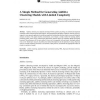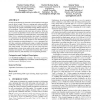1636 search results - page 127 / 328 » Using Bayesian Networks to Model Agent Relationships |
ML
2002
ACM
13 years 8 months ago
2002
ACM
Additive clustering was originally developed within cognitive psychology to enable the development of featural models of human mental representation. The representational flexibili...
KI
2010
Springer
13 years 7 months ago
2010
Springer
Recognizing human intentions is part of the decision process in many technical devices. In order to achieve natural interaction, the required estimation quality and the used comput...
JMLR
2010
13 years 3 months ago
2010
This paper introduces a Bayesian algorithm for constructing predictive models from data that are optimized to predict a target variable well for a particular instance. This algori...
ECAL
2007
Springer
14 years 3 months ago
2007
Springer
Abstract. This paper investigates the processes used by an evolved, embodied simulated agent to adapt to large disruptive changes in its sensor morphology, whilst maintaining perfo...
ATAL
2011
Springer
12 years 9 months ago
2011
Springer
In multi-agent planning environments, action models for each agent must be given as input. However, creating such action models by hand is difficult and time-consuming, because i...


